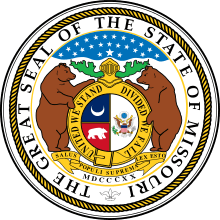George Caleb Bingham
| George Caleb Bingham | |
|---|---|
 A self-portrait by George Caleb Bingham, painted 1834–35 | |
| Born |
March 20, 1811 Augusta County, Virginia |
| Died |
July 7, 1879 (aged 68) Kansas City, Missouri |
| Nationality | American |
| Education | [Self taught by study of prints of Old Masters and copybooks] |
| Known for | Painting |
| Movement | Luminism |
George Caleb Bingham (March 20, 1811 – July 7, 1879) was an American artist whose paintings of American life in the frontier lands along the Missouri River exemplify the Luminist style. Left to languish in obscurity, Bingham's work was rediscovered in the 1930s. By the time of his bicentennial in 2011, he was considered one of the greatest American painters of the 19th century. That year the George Caleb Bingham Catalogue Raisonné Supplement Of Paintings & Drawings—directed and edited by Bingham scholar Fred R. Kline—announced the authentication of ten recently discovered paintings by Bingham. As of June 2015, a total of twenty-three (23) newly discovered paintings by Bingham have been authenticated and are listed with the GCBCRS.[1]
Early life and education
Born in Augusta County, Virginia,[2] George Caleb Bingham was the second of seven children of Mary Amend and Henry Vest Bingham. Upon their marriage, Mary's father Matthias Amend gave the Binghams ownership of the family mill, 1,180 acres (4.8 km2) land, and several slaves with the agreement that Matthias could live with the family for the rest of his life. Henry Bingham offered the land and mill as surety for a friend's debt and, when the friend died in 1818, all was lost. The Bingham family soon moved to Franklin, Missouri "where the land was said to be bountiful, fertile and cheap."[3]
George Bingham was a self-taught artist. His sole childhood exposure to the field was as a nine-year-old boy, when famed American portraitist Chester Harding visited Franklin looking for business, having recently sketched Daniel Boone in Warren County, Missouri. George assisted Harding during his brief stay, an experience that left a powerful impression.[3]
In 1823, Bingham's father Henry, then judge of Howard County Court, died of malaria on December 26 at the age of thirty-eight. To keep the family going, Mary Bingham opened a school for girls; George, then twelve, worked as school janitor to help keep the family afloat. At age sixteen, the young Bingham apprenticed with the cabinet maker Jesse Green. After Green moved away, Bingham apprenticed with another cabinet maker, Justinian Williams. Both tradesmen were Methodist ministers. While under their tutelage, Bingham studied religious texts, preached at camp meetings and thought about becoming a minister. He also considered becoming a lawyer.[3]
By age nineteen, Bingham was painting portraits for $20.00 apiece, often completing the works in a single day. He drummed up work in both Franklin and Arrow Rock and, while his painting abilities were still developing, succeeded in impressing his patrons with his strong draftsmanship and ability to capture the likeness of his subject. Soon Bingham was ready to travel to St. Louis to ply his trade but contracted measles. The illness left him weak and permanently bald.[4]
Marriage and family
_and_Son%2C_Newton_by_George_Caleb_Bingham.jpg)
In 1836, Bingham married Sarah Elizabeth Hutchison, who bore him four children over the next twelve years. From 1837 to 1845 they lived in Arrow Rock, Saline County, where their house has been designated a National Historic Landmark. She died in 1848 at the age of twenty-nine.[3] Bingham's mother Mary helped him raise his children before she died in 1851.[3]
Bingham married twice more, first to Eliza K. Thomas. After several years, she had to be institutionalized and died in a mental asylum in 1876. He next married the widow Martha Lykins, who lived until 1890.[3]
Career in St. Louis
By 1838, Bingham was already beginning to make a name as a portrait artist in St. Louis, the major city of the territory; his studio was visited by several prominent local citizens and statesmen, including the lawyer James S. Rollins, who was to become a lifelong friend. While he frequently worked in the city, Bingham kept his principal residence in Arrow Rock for years. To further his education, Bingham spent three months in Philadelphia, Pennsylvania before continuing on to New York City to visit the National Academy of Design exhibition.[4]
After moving his family to St. Louis permanently, Bingham was elected to the Missouri House of Representatives in 1848,[5] one of the few artists to serve in elected political office. His interest in politics was reflected in his paintings of the vivid political life on the frontier. Bingham later took several state political appointments as well.[6]
In 1856 Bingham moved to Europe with his second wife Eliza and youngest daughter. First they stayed in Paris for several months, where Bingham fulfilled a long-cherished desire and studied the Old Masters at the Louvre Museum, likely his chief reason for going abroad. They went on to Düsseldorf, Germany, where they lived until 1859, taking part in the Düsseldorf school of painting. Bingham lived and worked among the American and German artists of the art colony, among whom was the German-American Emanuel Leutze, the most prominent historical painter in the United States. (Washington Crossing the Delaware was then his most famous work.) Leutze was unusual for living in both countries and had an open studio in Düsseldorf, where he welcomed Bingham as a friend and already successful artist. While in Germany, Bingham worked on important commissions from the Missouri State Legislature, as well as independent paintings.
Upon his return to America, Bingham began painting more portraits, which had always been his "bread and butter" work. He also returned to politics, always as a member of the Whig Party. During the American Civil War, Bingham supported the Union and was appointed State Treasurer of Missouri.
He continued to stay involved in politics in the post-Civil War years through political appointments. In 1874, he was appointed president of Kansas City Board of Police Commissioners, and appointed the first chief of police there.[7] In 1875, the governor appointed Bingham as Adjutant-General of Missouri, and thereafter he was often referred to as General Bingham.
Toward the end of his life, although quite ill, Bingham was appointed the first Professor of Art at the University of Missouri in Columbia, Missouri. He met with only a few students before his death.
Fur Traders Descending the Missouri
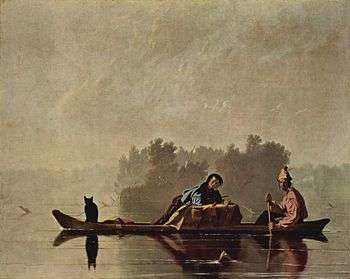
One of Bingham's most famous paintings, this work is owned by the Metropolitan Museum of Art in New York. Painted around 1845 in the style called luminism by some historians of American art, it was originally entitled, French Trader, Half-breed Son. The American Art Union thought the title potentially controversial and renamed it when it was first exhibited. It reflected the reality of fur trappers and traders frequently marrying Native American women in their territories; in Canada the ethnic Métis people have been recognized by the government as a distinct group with status similar to First Nations. The painting is haunting for its evocation of an era in American history—note, in particular, the liberty cap worn by the older man. A bear cub seated at the end of the boat is secured by a chain.[8][9]
The Election Series
Bingham's Election Series comprises three paintings: The County Election, Stump Speaking, and The Verdict of the People. Bingham intended for the Election Series to reach a national audience rather than Missourians alone. To spread his idea of free people and free institutions, Bingham exhibited his paintings in Washington and urged the Library Committee of Congress to purchase them so American leaders could view them. When the Library Committee of Congress decided to not purchase his trio, he lent the paintings to the Mercantile Library Association in St. Louis.[6]
The County Election
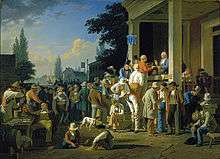
The first painting made for the Election Series shows the voting process in Missouri.[10] The County Election depicts a variety of people from several different social classes, such as young boys playing a game, two men talking about the election happening around them, and a mass of men walking up the stairs to vote.[11] A banner shows the words, "The Will of the People[,] The Supreme Law", a credo that had great meaning for Bingham. He believed that people had a right to share their ideas; he also believed that he lost his seat in legislature in 1846 due to the improper following of the people's will.[6] A mill in the background of the painting provided both a local detail and a reference to a Whig candidate who used a mill as a political symbol. The cedar barrels are evocative of a different Whig candidate who used cedar barrels as his political symbol.[12] In his first painting of The County Election, Bingham showed two men flipping a coin beneath a judge. The two people represent ex-governor Marmaduke's bet that he had placed on the election of Bingham versus his opponent, Erasmus Sappington. Bingham also purposefully kept the scene outside to represent universal suffrage, one of his beliefs. The openness of the setting shows that politics should happen in the open rather than behind the curtains of the government. The idea of universal suffrage agrees with Bingham's ideas of the will of the people: everyone should have the right to vote because the will of the people should be the supreme law.[6]
Though many people understood and supported the principles portrayed by Bingham, some believed that Bingham did not correctly portray his beliefs. A critic complained that the painting made a mockery of American principles by including details such as the drunkard voting in the foreground. The critic claimed that because Bingham had shown drinking and gambling as part of the election process, he was defaming the political process.[13]
The reference to Marmaduke in The County Election was only relative to Missouri, so in order to generalize the message of the painting to the nation, Bingham removed the two men tossing a coin in the print version.[6] In the corner of the original painting a newspaper title reads, "The Missouri Republican"; Bingham requested that the man who replicated his painting change the title to "The National Intelligencer" so that the painting would generalize to a larger audience.[10]
Stump Speaking
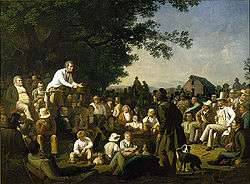
In the second painting of the trio, Stump Speaking, a politician persuades Missourians to vote in his favor. Depicted are three figures that stand out because of their startling bright white clothing: the "Stump Speaker", the "Outstanding Citizen" (the sitting man opposite of the speaker), and the "Small Businessman" (the young child in middle of the painting). Before the creation of the painting, Bingham had made preliminary sketches of the three aforementioned people, who represented Bingham's belief of the past, present, and future of American politics. The "Outstanding Citizen", as Bingham's sketch refers to him, represents the past as the man's sharp edges and fine clothes show how he is unwilling to bend his beliefs and instead works among the people. His sharp edges contrast with the softer curves of the "Stump Speaker", the character that represents the present of American politics. The "Stump Speaker" appears to be swaying the assembled crowd by bending to the people's desires, shown by the curving arm that is outstretched to the audience. The "Small Businessman" represents the future. That child shows how people are starting to focus more on their money, as the child is, and less on the politics, parallel to how the child is detached from the debate surrounding him. The three people represent "the Jeffersonian past, of statesmen and gentlemen farmers; the Jacksonian present, of demagogues, party hacks, and gullible citizens; and a materialistic future of isolated citizens with no common public life at all."[14]
Within Bingham's painting Stump Speaking, he creates a scene that has both a national message and a local message; some of the people portrayed in the paintings resemble local Missouri politicians. Behind the speaker sits a man resembling Bingham's self-portrait taking notes about the speech, waiting for his turn to speak. The "Stump Speaker" resembled Sappington, who was Bingham's opponent in his previous elections,[6] and the person sitting next to Bingham resembles the ex-governor of Missouri, Meredith Marmaduke.[10]
The Verdict of the People

The last painting of Bingham's Election Series, The Verdict of the People, tells the end of the story represented in the series. Within this painting, Bingham hid several political motives and ideas similar to the rest of the Election Series. Completed in 1854, the work covered issues of slavery, temperance, and a representative government, subjects that had gone from a local to a national level. During the early 1850s, the temperance movement grew and more states were abolishing alcohol. A book by Herman Humphrey, titled Parallel between Intemperance and Slavery, associated the cause of anti-slavery to that of temperance. Bingham showed his view on intemperance and slavery by painting a banner that said, "Freedom for Virtue[,] Restriction for Vice." The banner referred to temperance by saying that the vice and alcohol would need to be restricted for the people to be free. The banner then references Bingham's ideas of slavery by using the connection of the temperance movement and the anti-slavery movement to show that Bingham thought negatively about slavery and shared that view with intemperance.[6]
Legacy and honors
- Appointed first professor of art at the University of Missouri
- The George Caleb Bingham House in Arrow Rock, his principal residence from 1837–1845, was designated a National Historic Landmark.
- The University of Missouri has named the George Caleb Bingham Art Gallery in his honor.[15]
- George Caleb Bingham Middle School(Formerly George Caleb Bingham 7th Grade Center) In The Independence Public School District in Independence, Missouri was named after him because he served on the Independence Public School District Board Of Education.
Bingham Bicentennial 2011
The George Caleb Bingham Catalogue Raisonné Supplement Of Paintings & Drawings was begun in 2005, directed and edited by art historian Fred R. Kline with initial advisory board members Paul Nagel and William Kloss. At the Bingham Bicentennial, ten newly discovered paintings were announced by the GCBCRS; as of June 2015, the GCBCRS has added 23 paintings to Bingham's body of work. The paintings exhibited, catalogued, and illustrated online[1] include: Horse Thief (a political allegory posing the question of U.S. Constitutional law versus Vigilantism in the Western regions of the U.S.), Baiting the Hook (Bingham's first river genre), Young Fisherman, Hudson River Palisades (Bingham's only known Hudson River painting); and portraits including Colin Dunlop & His Dog, Lewis Allen Dicken Crenshaw, Fanny Smith Crenshaw, Frederick Moss Prewitt, Civil War Lt. Col. Levi Pritchard (Bingham's largest portrait at 80 inches high), Charles Chilton, Samuel Chilton, Thomas B. Hudson, Missouri Steamboat Capt. Joseph Kinney and Martha Lykins, a previously unidentified woman who has now been recognized as Bingham's third wife, painted years before their marriage.
The GCBCRS is built upon and continues E. Maurice Bloch's authoritative George Caleb Bingham Catalogue Raisonné of paintings and drawings, begun in the 1940s, which includes Bingham's known paintings up to 1986 (Bloch died in 1989). All 23 paintings authenticated by the GCBCRS Committee were unknown to Bloch. Nearly all Bingham's over 500 recorded paintings (460 are portraits) are unsigned, including famous ones such as Fur Traders Descending the Missouri, The Emigration of Daniel Boone, and The County Election. Bingham neglected record keeping and signing, allowing scores of paintings to remain unidentified. The GCBCRS is sponsored by Rachael Cozad Fine Art in Kansas City with publication in book form planned for the near future.
Gallery
 Jolly Flatboatmen, 1846
Jolly Flatboatmen, 1846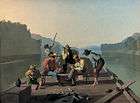 Raftsmen Playing Cards, 1847
Raftsmen Playing Cards, 1847 Lighter Relieving the Steamboat Aground, 1846–47
Lighter Relieving the Steamboat Aground, 1846–47 The Wood-boat, 1850
The Wood-boat, 1850 Mississippi Boatman, 1850
Mississippi Boatman, 1850 The Squatters, 1850
The Squatters, 1850 Shooting for the Beef, c. 1850
Shooting for the Beef, c. 1850 Daniel Boone Escorting Settlers through the Cumberland Gap, oil on canvas, 1851–52
Daniel Boone Escorting Settlers through the Cumberland Gap, oil on canvas, 1851–52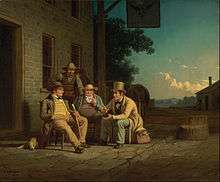 Canvassing for a Vote, 1852
Canvassing for a Vote, 1852 Jolly Flatboatmen in Port, 1857
Jolly Flatboatmen in Port, 1857 Washington Crossing the Delaware, 1856–71
Washington Crossing the Delaware, 1856–71 View of Pikes Peak, 1872
View of Pikes Peak, 1872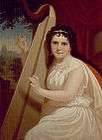 Portrait of Vinnie Ream, 1876
Portrait of Vinnie Ream, 1876
Works
- 1834 - Self Portrait, 1834–35, oil on canvas, Saint Louis Art Museum, St. Louis, MO
- 1837 - General Richard Gentry, oil on canvas, Saint Louis Art Museum, St. Louis, MO
- 1838 - Judge Henry Lewis, 1838–39, oil on canvas, Saint Louis Art Museum, St. Louis, MO
- 1838 - Mrs. Henry Lewis (Elizabeth Morton Woodson), 1838–39, oil on canvas, Saint Louis Art Museum, St. Louis, MO
- 1843 - The Dull Story, 1843–1844, oil on canvas, Saint Louis Art Museum, St. Louis, MO
- 1845 - Cottage Scenery, oil on canvas, Corcoran Gallery of Art, Washington, D.C.
- 1846 - Jolly Flatboatmen, oil on canvas, Saint Louis Art Museum, St. Louis, MO
- 1846 - Landscape with Cattle, oil on canvas, Saint Louis Art Museum, St. Louis, MO
- 1846 - Lighter Relieving the Steamboat Aground, 1846–47, oil on canvas
- 1847 - Raftsmen Playing Cards, oil on canvas, Saint Louis Art Museum, St. Louis, MO
- 1848 - The Student (Dr. Oscar Fitzland Potter), oil on canvas, Saint Louis Art Museum, St. Louis, MO
- 1850 - Mississippi Boatman, oil on canvas, National Gallery of Art, Washington, D.C.
- 1850 - The Wood-boat, oil on canvas mounted on board, Saint Louis Art Museum, St. Louis, MO
- 1850 - Shooting for the Beef, c. 1850, oil on canvas, Brooklyn Museum, New York City
- 1851 - Daniel Boone Escorting Settlers through the Cumberland Gap, oil on canvas, 1851–52
- 1852 - The County Election, oil on canvas, Saint Louis Art Museum, St. Louis, MO
- 1852 - Canvassing for a Vote, oil on canvas, Nelson-Atkins Museum, Kansas City, MO
- 1853 - Stump Speaking, 1853–54, oil on canvas, Saint Louis Art Museum, St. Louis, MO
- 1854 - The Verdict of the People, 1854–55, oil on canvas, Saint Louis Art Museum, St. Louis, MO
- 1856 - Old Field Horse, oil on canvas, Saint Louis Art Museum, St. Louis, MO
- 1856 - The Belated Wayfarers, oil on canvas, Saint Louis Art Museum, St. Louis, MO
- 1856 - Washington Crossing the Delaware, 1856–71, oil on canvas
- 1857 - Jolly Flatboatmen in Port, oil on canvas, Saint Louis Art Museum, St. Louis, MO
- 1872 - View of Pikes Peak, oil on canvas
- 1876 - Portrait of Vinnie Ream (Vinnie Ream), oil on canvas
See also
References
- 1 2 "George Caleb Bingham - Artist of Missouri and the American Frontier".
- ↑ Who Was Who in America, Historical Volume, 1607-1896 (Marquis Who's Who, 1967).
- 1 2 3 4 5 6 Nagel, Paul C., "The Man and His Times," in George Caleb Bingham, ed. Michael Edward Shapiro (Harry N. Abrams, Inc., 1990).
- 1 2 Christ-Janer, Albert, George Caleb Bingham: Frontier Painter of Missouri, New York: Harry N. Abrams, Inc., 1975
- ↑ "Missouri Legislators B". mo.gov. Retrieved 21 June 2015.
- 1 2 3 4 5 6 7 Rash, Nancy, The Painting And Politics of George Caleb Bingham (Yale University Press, 1991).
- ↑ "About Us", Kansas City Police Department, 2004
- ↑ "George Caleb Bingham: Fur Traders Descending the Missouri (33.61) - Heilbrunn Timeline of Art History - The Metropolitan Museum of Art".
- ↑ Schwartz, Sanford (June 25, 2015). "The Lure of Life on the Missouri". The New York Review of Books 62 (11): 51–52.
- 1 2 3 Shapiro, Michael (1993). George Caleb Bingham. New York: Harry N. Abrams Inc.
- ↑ Laura Rigal, "Black Work at the Polling Place: the Color Line in'The County Election'." Common-place: the Journal of Early American Life 9.1 (2008). online
- ↑ Groseclose, Barbara (1987). "Painting, Politics, and George Caleb Bingham". American Art Journal.
- ↑ Nagel, Paul (2005). George Caleb Bingham : Missouri's Famed Painter and Forgotten Politician. University of Missouri.
- ↑ Casper, Scott (1991). "Politics, Art, and the Contradictions of a Market Culture: George Caleb Bingham's 'Stump Speaking'". American Art.
- ↑ "George Caleb Bingham Gallery".
Further reading
- Nagel, Paul C. George Caleb Bingham: Missouri's Famed Painter and Forgotten Politician (University of Missouri Press, 2005). xx, 161 pp. heavily illustrated.
External links
| Wikimedia Commons has media related to George Caleb Bingham. |
- Art and the empire city: New York, 1825-1861, an exhibition catalog from The Metropolitan Museum of Art (fully available online as PDF), which contains material on George Caleb Bingham (see index)
- Paintings from the Permanent Collection of the Utah Museum of Fine Arts
- George Caleb Bingham Catalogue Raisonné Supplement of Paintings and Drawings, edited and directed by Fred R. Kline
- Cottage Scenery, 1845, Corcoran Gallery of Art, Washington, D.C.
- Works by George Caleb Bingham at the State Historical Society of Missouri
- Paintings Gallery
| Political offices | ||
|---|---|---|
| Preceded by Alfred William Morrison |
Missouri State Treasurer 1862–1865 |
Succeeded by William Bishop |

